Nicholas P. Cheremisinoff. Handbook of Solid Waste Management and Waste Minimization Technologies
Подождите немного. Документ загружается.


Air emissions should be monitored regularly for particulate matter and fluorides.
Hydrocarbon emissions should be monitored annually on the anode plant and
baking furnaces. Liquid effluents should be monitored weekly for pH, total
suspended solids, fluoride, and aluminum and at least monthly for other
parameters. Monitoring data should be analyzed and reviewed at regular intervals
and compared with the operating standards so that any necessary corrective
actions can be taken.
IRON AND STEEL
INDUSTRY DESCRIPTION AND PRACTICES
Steel is an alloy of iron usually containing less than
1
% carbon. The process of
steel production requires several sequential steps. The two types of steelmaking
technology in use today are the basic oxygen furnace (BOF) and the electric arc
furnace (EAF). Although these two technologies use different input materials, the
output for both furnace types is molten steel which is subsequently formed into
steel mill products. The BOF input materials are molten iron, scrap, and oxygen.
In the EAF, electricity and scrap are the input materials used. BOFs are typically
used for high tonnage production of carbon steels, while EAFs are used to
produce carbon steels and low tonnage alloy and specialty steels. The processes
leading up to steelmaking in a BOF are very different than the steps preceding
steelmaking in an EAF; the steps after each of these processes producing molten
steel are the same.
Steel manufacturing may be defined as the chemical reduction of iron ore, using
an integrated steel manufacturing process or a direct reduction process. In the
conventional integrated steel manufacturing process, the iron from the blast
furnace is converted to steel in a BOF. As noted, it can also be made in an
electric arc furnace (EAF) from scrap steel and, in some cases, from direct
reduced iron. An emerging technology, direct steel manufacturing, produces steel
directly from iron ore. In the BOF process, coke making and iron making
precede steelmaking; these steps are not necessary with an EAF. Pig iron is
manufactured from sintered, pelletized, or lump iron ores using coke and
limestone in a blast furnace. It is then fed to a BOF in molten form along with
scrap metal, fluxes, alloys, and high-purity oxygen to manufacture steel. In some
integrated steel mills, sintering (heating without melting) is used to agglomerate
fines and so recycle iron-rich material such as mill scale.

When making steel using a BOF, coke-making and iron-making precede
steelmaking; these steps are not needed for steelmaking with an EAF. Coke,
which is the fuel and carbon source, is produced by heating coal in the absence of
oxygen at high temperatures in coke ovens. Hence, merchant coke plants are
needed to support industry based on this technology. Pig iron is then produced by
heating the coke, iron ore, and limestone in a blast furnace. In the BOF, molten
iron from the blast furnace is combined with flux and scrap steel where high-
purity oxygen is injected. This process, with coke-making, iron-making,
steelmaking, and subsequent forming and finishing operations is referred to as
fully integrated production. Alternatively, in an EAF, the input material is
primarily scrap steel, which is melted and refined by passing an electric current
from the electrodes through the scrap. The molten steel from either process is
formed into ingots or slabs that are rolled into finished products. Rolling
operations may require reheating, rolling, cleaning, and coating the steel.
Descriptions of both steelmaking processes follow.
Basic Oxygen Furnace Technology
The process of making steel in a BOF is preceded by coke-making and
ironmaking operations. In coke-making, coke is produced from coal. In
ironmaking, molten iron is produced from iron ore and coke. Each of these
processes and the subsequent steelmaking process in the BOF are briefly
described below.
Coke-making. Coal processing typically involves producing coke, coke gas and
by-product chemicals from compounds released from the coal during the coke-
making process. Coke is carbon-rich and is used as a carbon source and fuel to
heat and melt iron ore in ironmaking. The coke-making process starts with
bituminous pulverized coal charge which is fed into the coke oven through ports
in the top of the oven. After charging, the oven ports are sealed and the coal is
heated at high temperatures (1600 to 2300° F) in the absence of oxygen. Coke
manufacturing is done in a batch mode where each cycle lasts for 14 to 36 hours.
A coke oven battery comprises a series of 10 to 100 individual ovens, side-by-
side,
with a heating flue between each oven pair. Volatile compounds are driven
from the coal, collected from each oven, and processed for recovery of
combustible gases and other coal by-products. The solid carbon remaining in the
oven is the coke. The necessary heat for distillation is supplied by external
combustion of fuels (e.g., recovered coke oven gas, blast furnace gas) through
flues located between ovens.
At the end of the heating cycle, the coke is pushed from the oven into a rail
quench car. The quench car takes it to the quench tower, where the hot coke is
cooled with a water spray. The coke is then screened and sent to the blast furnace
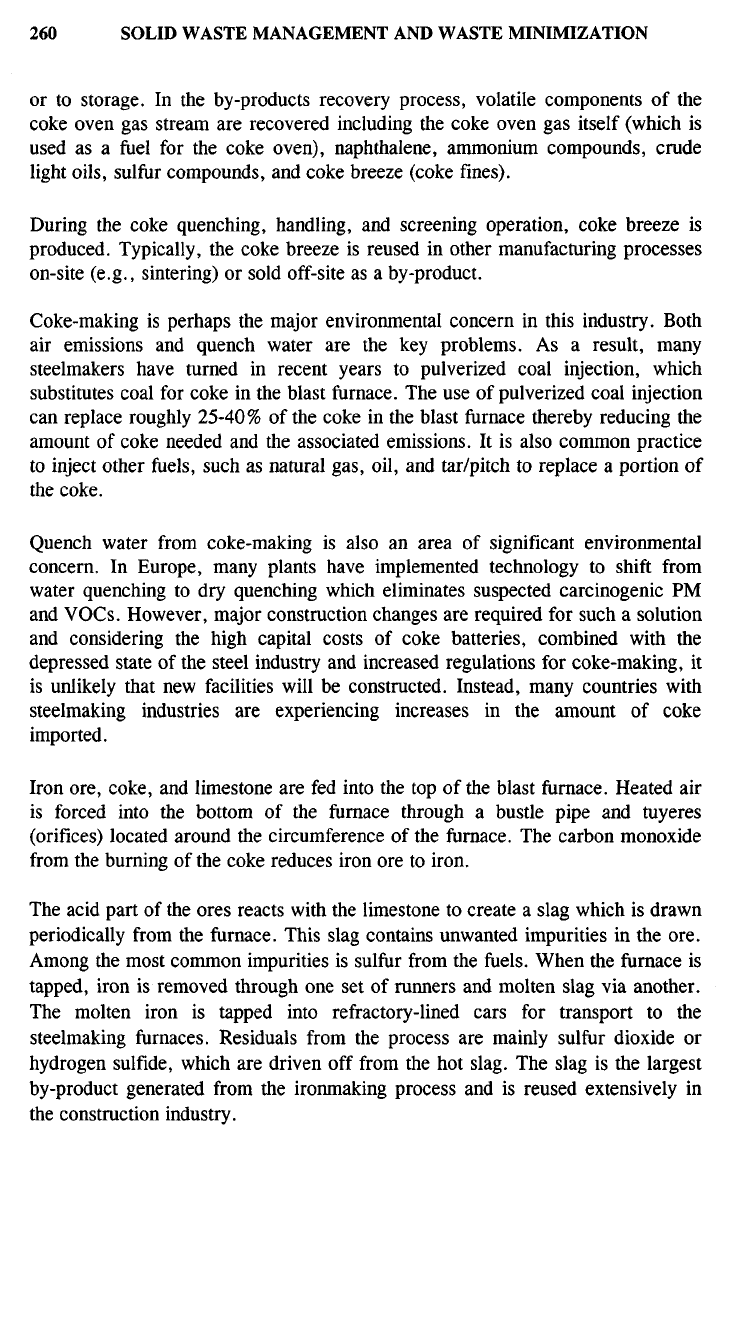
or to storage. In the by-products recovery process, volatile components of the
coke oven gas stream are recovered including the coke oven gas itself (which is
used as a fuel for the coke oven), naphthalene, ammonium compounds, crude
light oils, sulfur compounds, and coke breeze (coke fines).
During the coke quenching, handling, and screening operation, coke breeze is
produced. Typically, the coke breeze is reused in other manufacturing processes
on-site (e.g., sintering) or sold off-site as a by-product.
Coke-making is perhaps the major environmental concern in this industry. Both
air emissions and quench water are the key problems. As a result, many
steelmakers have turned in recent years to pulverized coal injection, which
substitutes coal for coke in the blast furnace. The use of pulverized coal injection
can replace roughly 25-40% of the coke in the blast furnace thereby reducing the
amount of coke needed and the associated emissions. It is also common practice
to inject other fuels, such as natural gas, oil, and tar/pitch to replace a portion of
the coke.
Quench water from coke-making is also an area of significant environmental
concern. In Europe, many plants have implemented technology to shift from
water quenching to dry quenching which eliminates suspected carcinogenic PM
and VOCs. However, major construction changes are required for such a solution
and considering the high capital costs of coke batteries, combined with the
depressed state of the steel industry and increased regulations for coke-making, it
is unlikely that new facilities will be constructed. Instead, many countries with
steelmaking industries are experiencing increases in the amount of coke
imported.
Iron ore, coke, and limestone are fed into the top of the blast furnace. Heated air
is forced into the bottom of the furnace through a bustle pipe and tuyeres
(orifices) located around the circumference of the furnace. The carbon monoxide
from the burning of the coke reduces iron ore to iron.
The acid part of the ores reacts with the limestone to create a slag which is drawn
periodically from the furnace. This slag contains unwanted impurities in the ore.
Among the most common impurities is sulfur from the fuels. When the furnace is
tapped, iron is removed through one set of runners and molten slag via another.
The molten iron is tapped into refractory-lined cars for transport to the
steelmaking furnaces. Residuals from the process are mainly sulfur dioxide or
hydrogen sulfide, which are driven off from the hot slag. The slag is the largest
by-product generated from the ironmaking process and is reused extensively in
the construction industry.
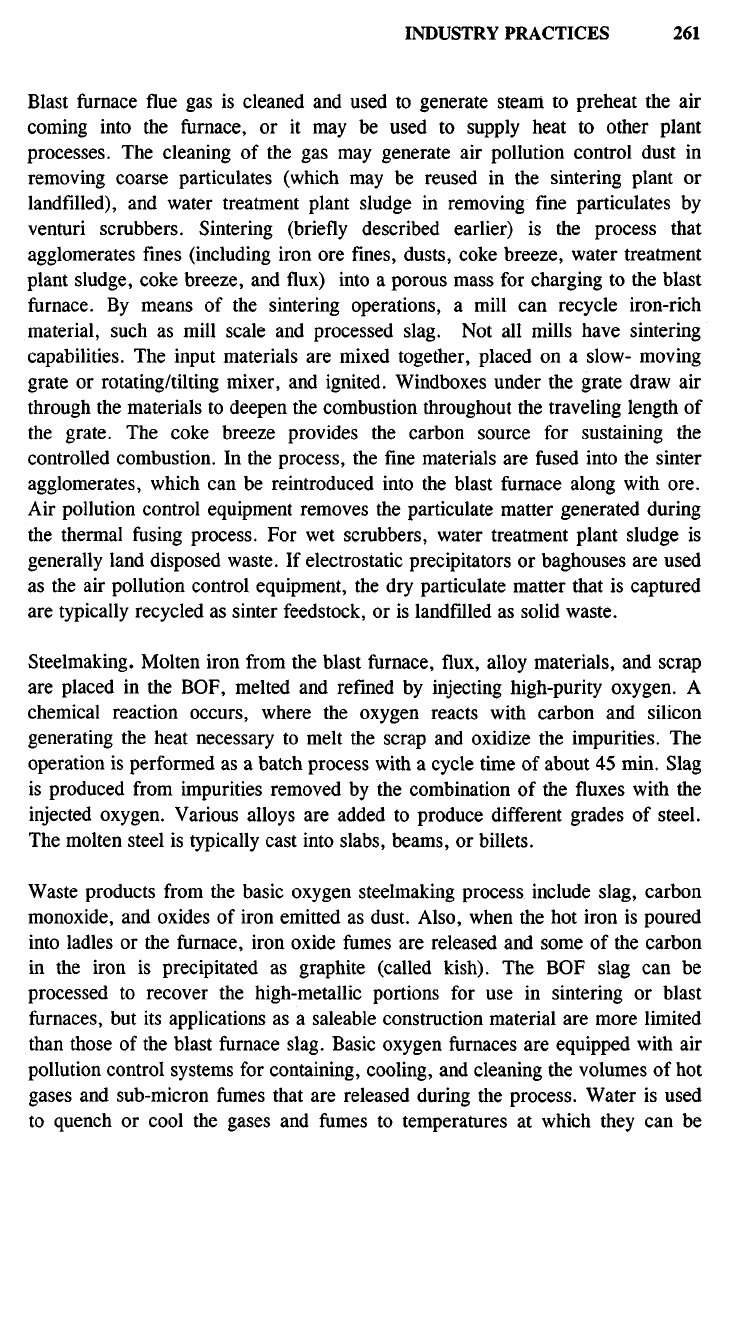
Blast furnace flue gas is cleaned and used to generate steam to preheat the air
coming into the furnace, or it may be used to supply heat to other plant
processes. The cleaning of the gas may generate air pollution control dust in
removing coarse particulates (which may be reused in the sintering plant or
landfilled), and water treatment plant sludge in removing fine particulates by
venturi scrubbers. Sintering (briefly described earlier) is the process that
agglomerates fines (including iron ore fines, dusts, coke breeze, water treatment
plant sludge, coke breeze, and flux) into a porous mass for charging to the blast
furnace. By means of the sintering operations, a mill can recycle iron-rich
material, such as mill scale and processed slag. Not all mills have sintering
capabilities. The input materials are mixed together, placed on a slow- moving
grate or rotating/tilting mixer, and ignited. Windboxes under the grate draw air
through the materials to deepen the combustion throughout the traveling length of
the grate. The coke breeze provides the carbon source for sustaining the
controlled combustion. In the process, the fine materials are fused into the sinter
agglomerates, which can be reintroduced into the blast furnace along with ore.
Air pollution control equipment removes the particulate matter generated during
the thermal fusing process. For wet scrubbers, water treatment plant sludge is
generally land disposed waste. If electrostatic precipitators or baghouses are used
as the air pollution control equipment, the dry particulate matter that is captured
are typically recycled as sinter feedstock, or is landfilled as solid waste.
Steelmaking. Molten iron from the blast furnace, flux, alloy materials, and scrap
are placed in the BOF, melted and refined by injecting high-purity oxygen. A
chemical reaction occurs, where the oxygen reacts with carbon and silicon
generating the heat necessary to melt the scrap and oxidize the impurities. The
operation is performed as a batch process with a cycle time of about 45 min. Slag
is produced from impurities removed by the combination of the fluxes with the
injected oxygen. Various alloys are added to produce different grades of steel.
The molten steel is typically cast into slabs, beams, or billets.
Waste products from the basic oxygen steelmaking process include slag, carbon
monoxide, and oxides of iron emitted as dust. Also, when the hot iron is poured
into ladles or the furnace, iron oxide fumes are released and some of the carbon
in the iron is precipitated as graphite (called kish). The BOF slag can be
processed to recover the high-metallic portions for use in sintering or blast
furnaces, but its applications as a saleable construction material are more limited
than those of the blast furnace slag. Basic oxygen furnaces are equipped with air
pollution control systems for containing, cooling, and cleaning the volumes of hot
gases and sub-micron fumes that are released during the process. Water is used
to quench or cool the gases and fumes to temperatures at which they can be
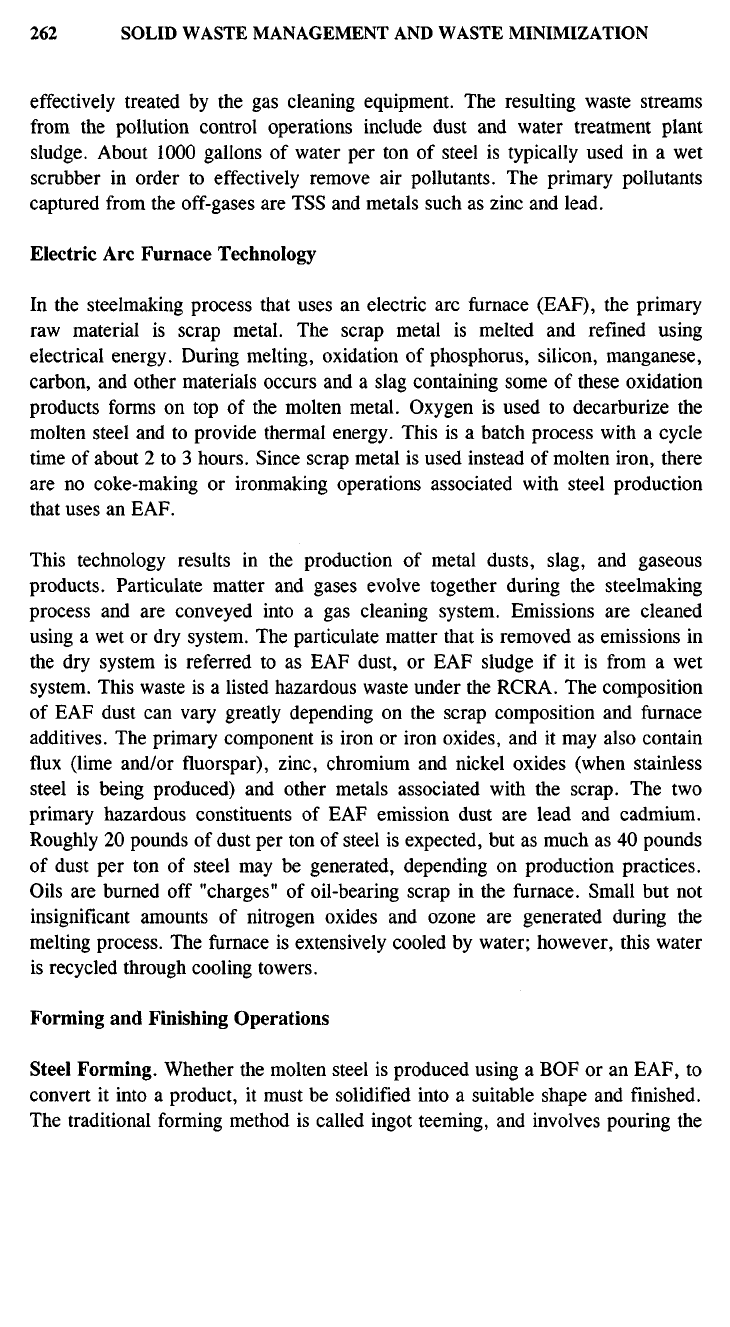
effectively treated by the gas cleaning equipment. The resulting waste streams
from the pollution control operations include dust and water treatment plant
sludge. About 1000 gallons of water per ton of steel is typically used in a wet
scrubber in order to effectively remove air pollutants. The primary pollutants
captured from the off-gases are TSS and metals such as zinc and lead.
Electric Arc Furnace Technology
In the steelmaking process that uses an electric arc furnace (EAF), the primary
raw material is scrap metal. The scrap metal is melted and refined using
electrical energy. During melting, oxidation of phosphorus, silicon, manganese,
carbon, and other materials occurs and a slag containing some of these oxidation
products forms on top of the molten metal. Oxygen is used to decarburize the
molten steel and to provide thermal energy. This is a batch process with a cycle
time of about 2 to 3 hours. Since scrap metal is used instead of molten iron, there
are no coke-making or ironmaking operations associated with steel production
that uses an EAF.
This technology results in the production of metal dusts, slag, and gaseous
products. Paniculate matter and gases evolve together during the steelmaking
process and are conveyed into a gas cleaning system. Emissions are cleaned
using a wet or dry system. The particulate matter that is removed as emissions in
the dry system is referred to as EAF dust, or EAF sludge if it is from a wet
system. This waste is a listed hazardous waste under the RCRA. The composition
of EAF dust can vary greatly depending on the scrap composition and furnace
additives. The primary component is iron or iron oxides, and it may also contain
flux (lime and/or fluorspar), zinc, chromium and nickel oxides (when stainless
steel is being produced) and other metals associated with the scrap. The two
primary hazardous constituents of EAF emission dust are lead and cadmium.
Roughly 20 pounds of dust per ton of steel is expected, but as much as 40 pounds
of dust per ton of steel may be generated, depending on production practices.
Oils are burned off "charges" of oil-bearing scrap in the furnace. Small but not
insignificant amounts of nitrogen oxides and ozone are generated during the
melting process. The furnace is extensively cooled by water; however, this water
is recycled through cooling towers.
Forming and Finishing Operations
Steel Forming. Whether the molten steel is produced using a BOF or an EAF, to
convert it into a product, it must be solidified into a suitable shape and finished.
The traditional forming method is called ingot teeming, and involves pouring the

metal into ingot molds, then allowing the steel to cool and solidify. The
alternative method of forming steel is called continuous casting. This process
bypasses several steps of the conventional ingot teeming process by casting steel
directly into semifinished shapes. Molten steel is poured into a reservoir from
which it is released into the molds of the casting machine. The metal is cooled as
it descends through the molds, and before emerging, a hardened outer shell is
formed. As the semifinished shapes proceed on the runout table, the center also
solidifies, allowing the cast shape to be cut into lengths. Process contact water
cools the continuously cast steel and is collected in settling basins along with oil,
grease, and mill scale generated in the casting process. The scale settles out and
is removed and recycled for sintering operations, if the mill has a sinter plant.
Waste treatment plant sludge is also generated during the operation. The steel is
further processed to produce slabs, strips, bars, or plates through various
forming steps. The most common hot forming operation is hot rolling, where
heated steel is passed between two rolls revolving in opposite directions. Hot
rolling units may have as many as 13 stands, each producing an incremental
reduction in thickness. The final shape and characteristics of a hot formed piece
depend on the rolling temperature, the roll profile, and the cooling process after
rolling. Wastes generated from hot rolling include waste treatment plant sludge
and scale.
In subsequent cold forming, the cross-sectional area of unheated steel is
progressively reduced in thickness as the steel passes through a series of rolling
stands. Generally, wires, tubes, sheet and strip steel products are produced by
cold-rolling operations. Cold forming is used to obtain improved mechanical
properties, better machinability, special size accuracy, and the production of
thinner gages than hot rolling can accomplish economically. During cold rolling,
the steel becomes hard and brittle. To make the steel more ductile, it is heated in
an annealing furnace. Process contact water is used as a coolant for rolling mills
to keep the surface of the steel clean between roller passes. Cold rolling
operations also produce a waste treatment plant sludge, primarily due to the
lubricants applied during rolling. Grindings from resurfacing of the worn rolls
and disposal of used rolls can be a significant contributor to the wastestream.
Finishing Stages. One of the most important aspects of a finished product is the
surface quality. To prevent corrosion, a protective coating is usually applied to
the steel product. Prior to coating, the surface of the steel must be cleaned so the
coating will adhere to the steel. Mill scale, rust, oxides, oil, grease, and soil are
chemically removed from the surface of steel using solvent cleaners, pressurized
water or air blasting, cleaning with abrasives, alkaline agents or acid pickling. In
the pickling process, the steel surface is chemically cleaned of scale, rust, and
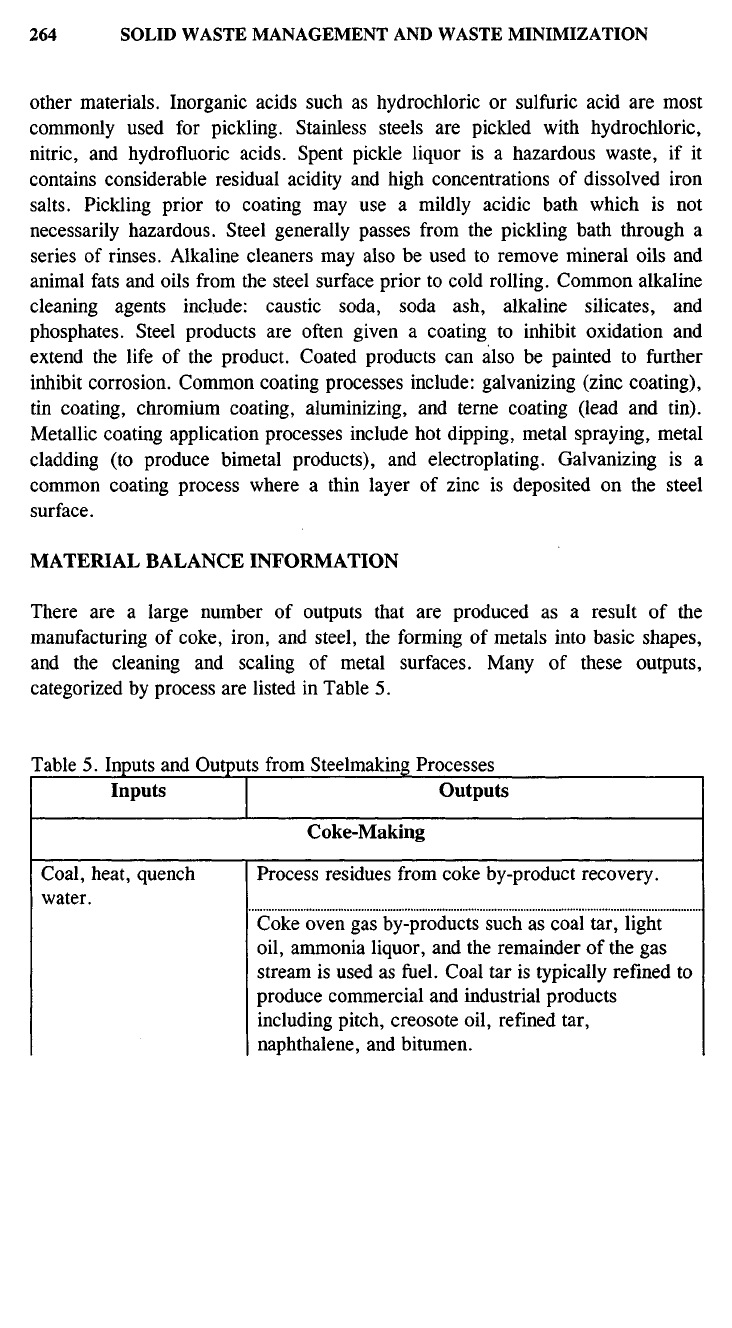
other materials. Inorganic acids such as hydrochloric or sulfuric acid are most
commonly used for pickling. Stainless steels are pickled with hydrochloric,
nitric,
and hydrofluoric acids. Spent pickle liquor is a hazardous waste, if it
contains considerable residual acidity and high concentrations of dissolved iron
salts.
Pickling prior to coating may use a mildly acidic bath which is not
necessarily hazardous. Steel generally passes from the pickling bath through a
series of rinses. Alkaline cleaners may also be used to remove mineral oils and
animal fats and oils from the steel surface prior to cold rolling. Common alkaline
cleaning agents include: caustic soda, soda ash, alkaline silicates, and
phosphates. Steel products are often given a coating to inhibit oxidation and
extend the life of the product. Coated products can also be painted to further
inhibit corrosion. Common coating processes include: galvanizing (zinc coating),
tin coating, chromium coating, aluminizing, and terne coating (lead and tin).
Metallic coating application processes include hot dipping, metal spraying, metal
cladding (to produce bimetal products), and electroplating. Galvanizing is a
common coating process where a thin layer of zinc is deposited on the steel
surface.
MATERIAL BALANCE INFORMATION
There are a large number of outputs that are produced as a result of the
manufacturing of coke, iron, and steel, the forming of metals into basic shapes,
and the cleaning and scaling of metal surfaces. Many of these outputs,
categorized by process are listed in Table 5.
Table 5. Inputs and Outputs from Steelmaking Processes
Inputs
Outputs
Coke-Making
Coal, heat, quench
water.
Process residues from coke by-product recovery.
Coke oven gas by-products such as coal tar, light
oil,
ammonia liquor, and the remainder of the gas
stream is used as fuel. Coal tar is typically refined to
produce commercial and industrial products
including pitch, creosote oil, refined tar,
naphthalene, and bitumen.
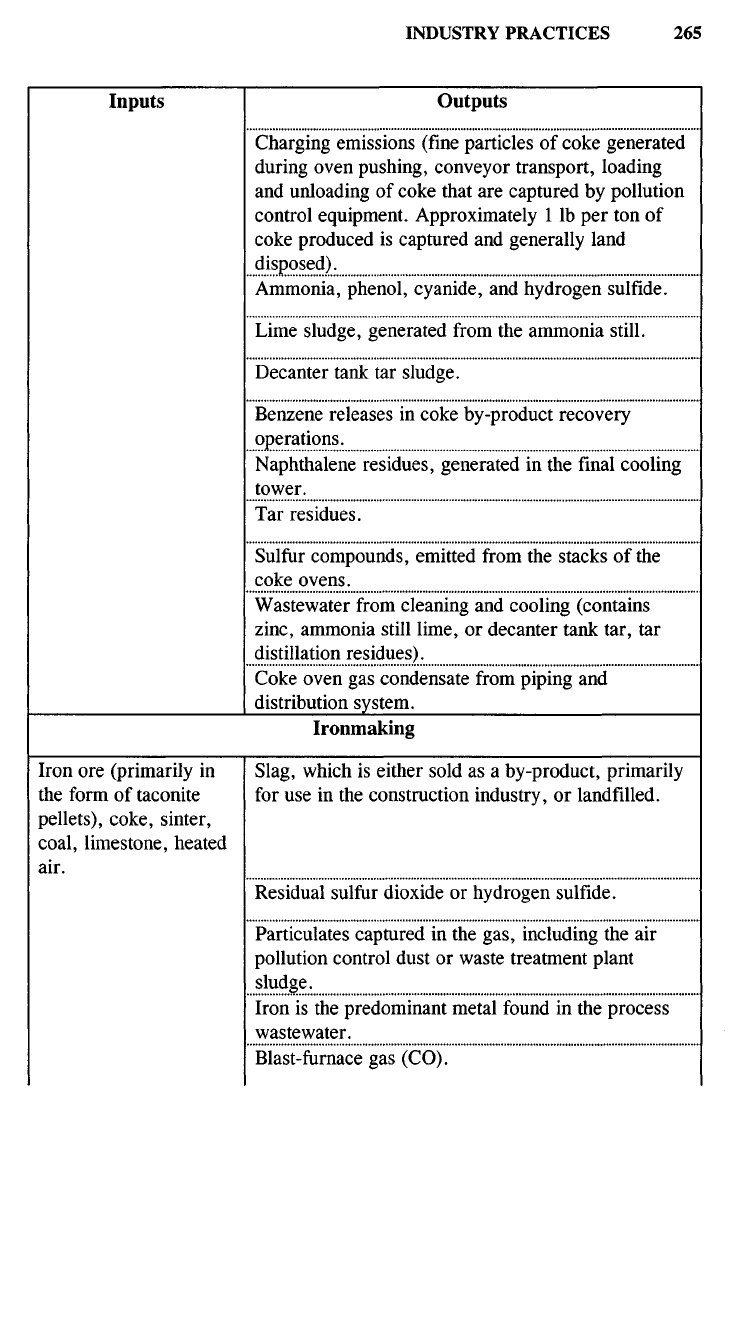
Inputs
Outputs
Charging emissions (fine particles of coke generated
during oven pushing, conveyor transport, loading
and unloading of coke that are captured by pollution
control equipment. Approximately 1 Ib per ton of
coke produced is captured and generally land
disposed).
Ammonia, phenol, cyanide, and hydrogen sulfide.
Lime sludge, generated from the ammonia still.
Decanter tank tar sludge.
Benzene releases in coke by-product recovery
operations.
Naphthalene residues, generated in the final cooling
tower.
Tar residues.
Sulfur compounds, emitted from the stacks of the
coke ovens.
Wastewater from cleaning and cooling (contains
zinc,
ammonia still lime, or decanter tank tar, tar
distillation residues).
Coke oven gas condensate from piping and
distribution system.
Ironmaking
Iron ore (primarily in
the form of taconite
pellets), coke, sinter,
coal, limestone, heated
air.
Slag, which is either sold as a by-product, primarily
for use in the construction industry, or landfilled.
Residual sulfur dioxide or hydrogen sulfide.
Particulates captured in the gas, including the air
pollution control dust or waste treatment plant
sludge.
Iron is the predominant metal found in the process
wastewater.
Blast-furnace gas (CO).
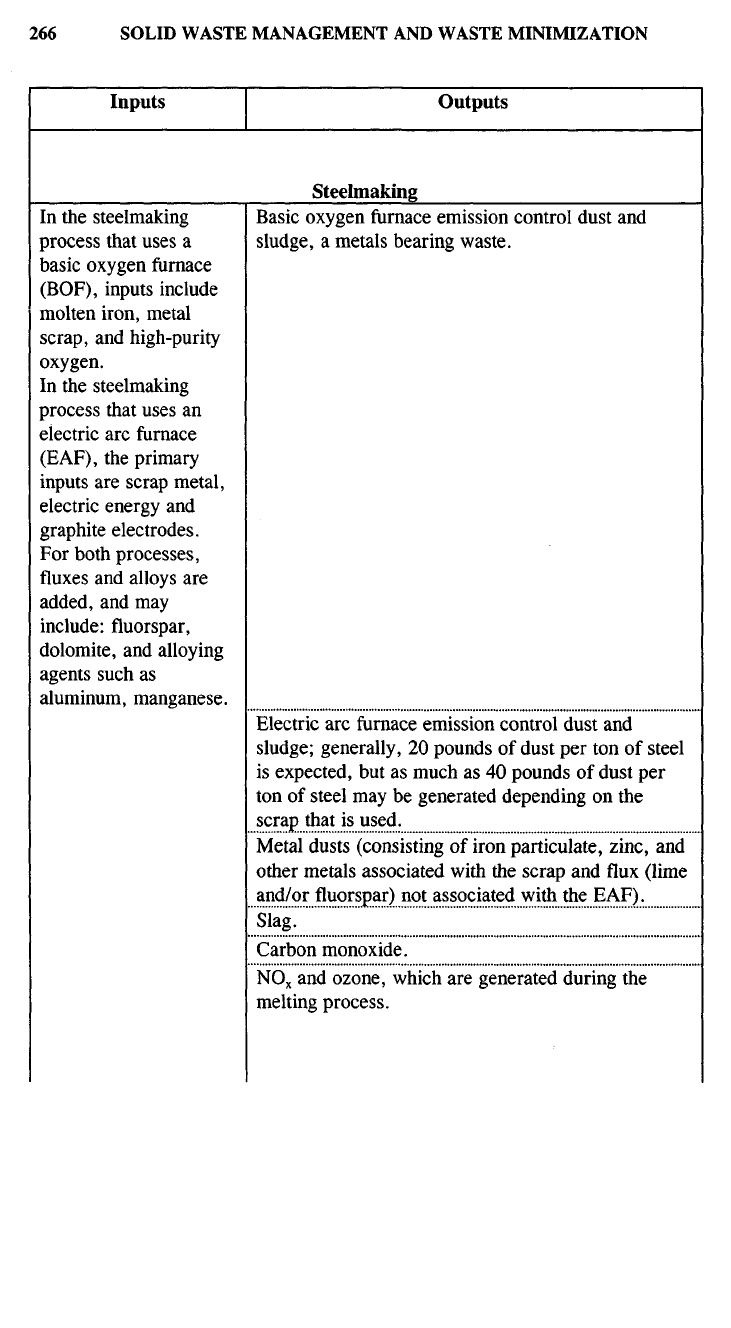
Inputs
In the steelmaking
process that uses a
basic oxygen furnace
(BOF),
inputs include
molten iron, metal
scrap,
and high-purity
oxygen.
In the steelmaking
process that uses an
electric arc furnace
(EAF),
the primary
inputs are scrap metal,
electric energy and
graphite electrodes.
For both processes,
fluxes and alloys are
added, and may
include: fluorspar,
dolomite, and alloying
agents such as
aluminum, manganese.
Outputs
Steelmaking
Basic oxygen furnace emission control dust and
sludge, a metals bearing waste.
Electric arc furnace emission control dust and
sludge; generally, 20 pounds of dust per ton of steel
is expected, but as much as 40 pounds of dust per
ton of steel may be generated depending on the
scrap that is used.
Metal dusts (consisting of iron particulate, zinc, and
other metals associated with the scrap and flux (lime
and/or fluorspar) not associated with the EAF).
Slag.
Carbon monoxide.
NO
x
and ozone, which are generated during the
melting process.
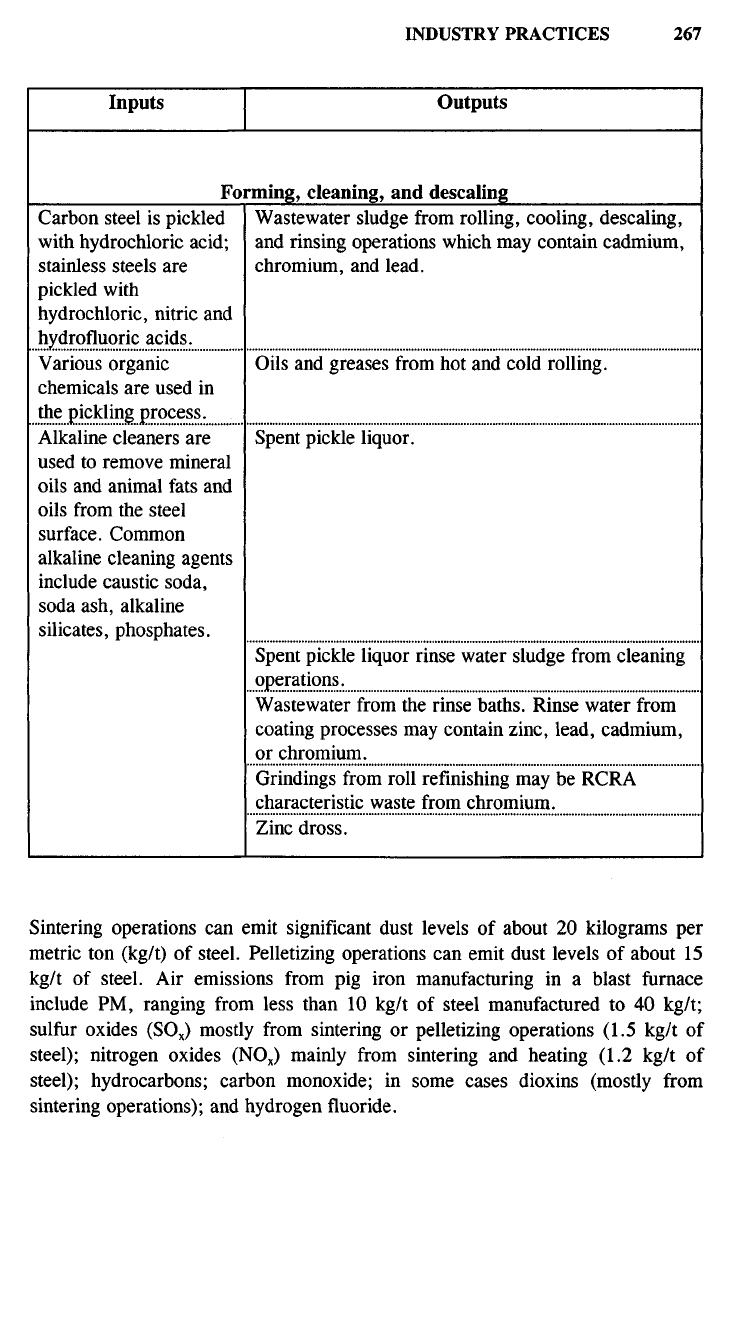
Inputs
Outputs
Forming, cleaning, and descaling
Carbon steel is pickled
with hydrochloric acid;
stainless steels are
pickled with
hydrochloric, nitric and
hydrofluoric acids.
Various organic
chemicals are used in
the pickling process.
Alkaline cleaners are
used to remove mineral
oils and animal fats and
oils from the steel
surface. Common
alkaline cleaning agents
include caustic soda,
soda ash, alkaline
silicates, phosphates.
Wastewater sludge from rolling, cooling, descaling,
and rinsing operations which may contain cadmium,
chromium, and lead.
Oils and greases from hot and cold rolling.
Spent pickle liquor.
Spent pickle liquor rinse water sludge from cleaning
operations.
Wastewater from the rinse baths. Rinse water from
coating processes may contain zinc, lead, cadmium,
or chromium.
Grindings from roll refinishing may be RCRA
characteristic waste from chromium.
Zinc dross.
Sintering operations can emit significant dust levels of about 20 kilograms per
metric ton (kg/t) of steel. Pelletizing operations can emit dust levels of about 15
kg/t of steel. Air emissions from pig iron manufacturing in a blast furnace
include PM, ranging from less than 10 kg/t of steel manufactured to 40 kg/t;
sulfur oxides (SO
x
) mostly from sintering or pelletizing operations (1.5 kg/t of
steel);
nitrogen oxides (NO
x
) mainly from sintering and heating (1.2 kg/t of
steel);
hydrocarbons; carbon monoxide; in some cases dioxins (mostly from
sintering operations); and hydrogen fluoride.
